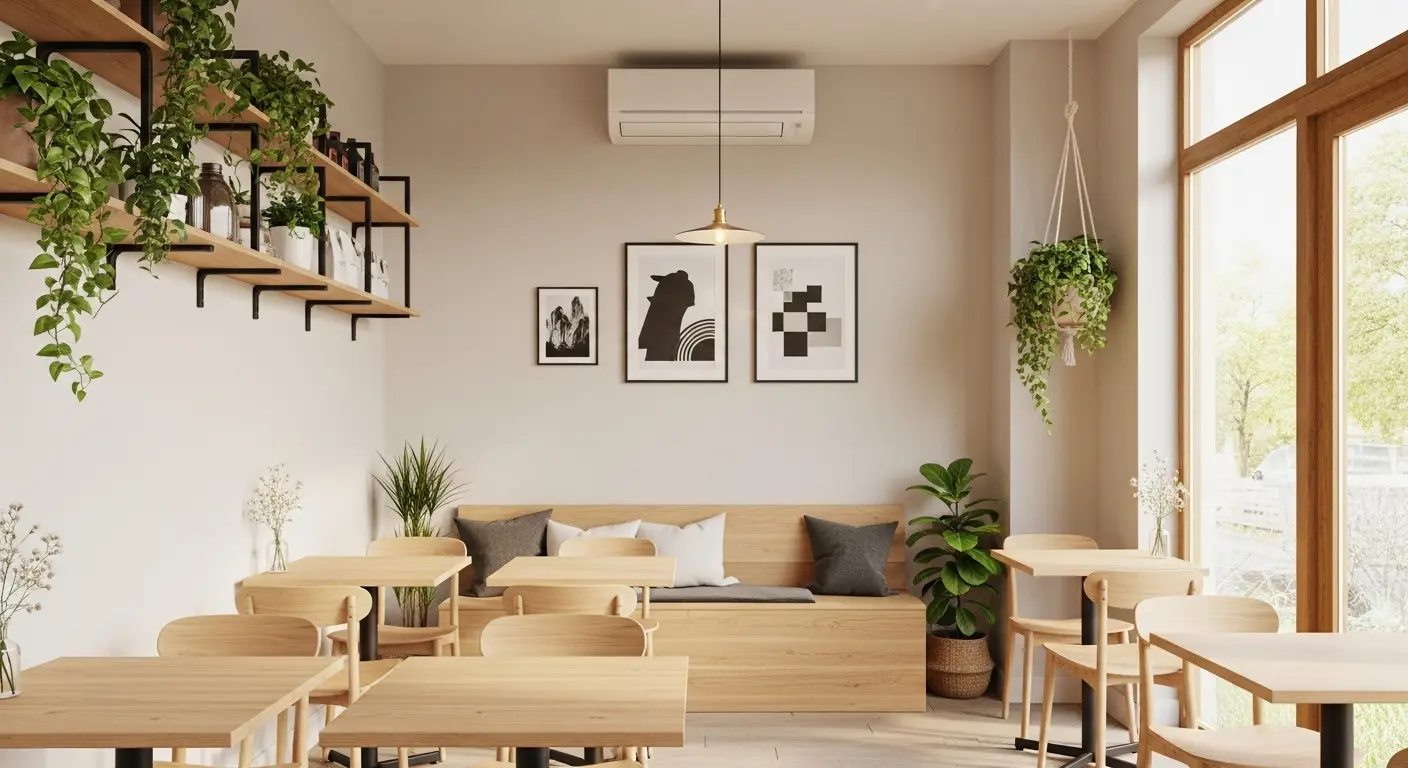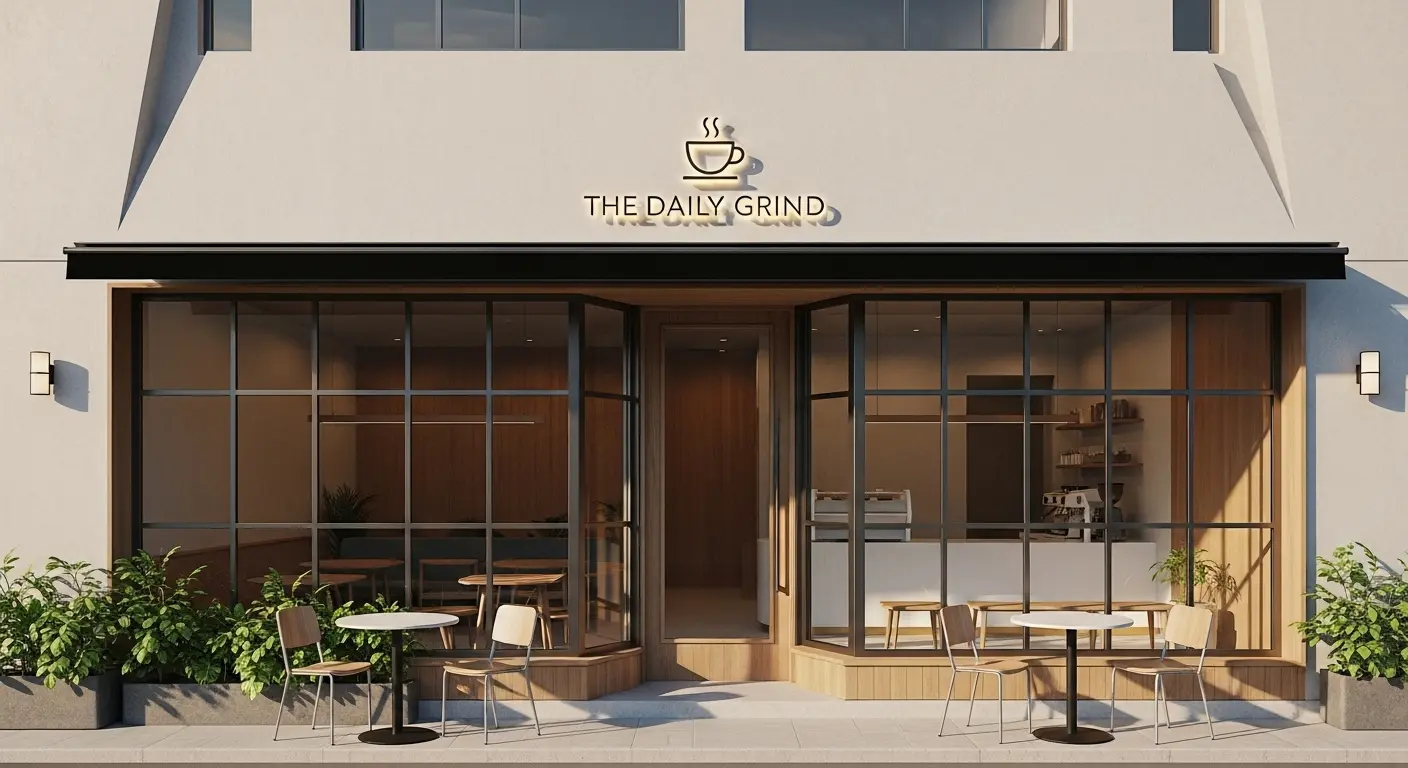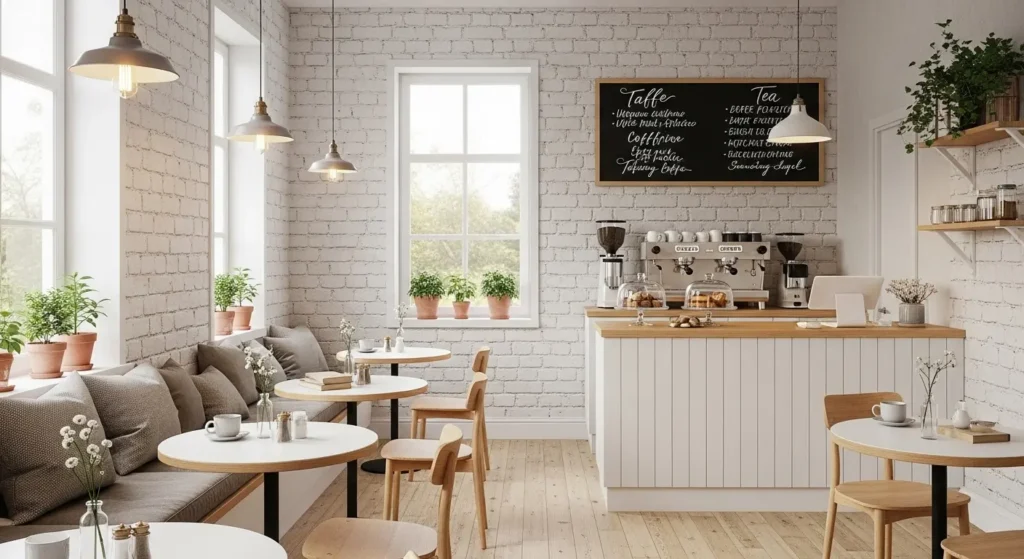
Minimalist coffee shops are gaining increasing prominence in the world of design and conscious entrepreneurship. With light, organized, and meaningful environments, this style offers more than just beauty: it provides welcoming, functional, and intentional experiences. In times of visual excess, creating coffee spaces focused on the essential is a way to promote well-being and authenticity.
In this visual guide, you will find real inspirations, practical tips, and key elements to transform or set up your own minimalist coffee shop — whether in a few square meters or as a new business model.
What is a Minimalist Coffee Shop?
Minimalist coffee shops combine aesthetic simplicity, functionality, and purpose. Far beyond a visual trend, they represent a new way of thinking about space and consumption: lean, intelligent, and emotionally welcoming.
But after all, what defines a coffee shop as “minimalist”?
The Essence of Minimalism Applied to Coffee
Minimalist design is based on the idea that less is more — fewer distractions, fewer superfluous elements, more clarity, harmony, and well-being. In a coffee shop, this philosophy translates into light, clean, and well-planned environments, with a total focus on the customer’s sensory experience and the quality of the product served.
Key elements that characterize a minimalist coffee shop:
- Neutral color palette (white, beige, gray, light wood);
- Functional furniture with simple lines;
- Natural lighting and indirect light points;
- Visually “breathable” and well-organized space;
- Absence of decorative excesses;
- Clear signage and a concise menu.
This type of environment invites conscious pause. It is a space that calms, stimulates focus, and prioritizes comfort without exaggeration.
Origins and Cultural Influences of the Minimalist Style
Minimalist coffee shops are strongly influenced by Japanese and Scandinavian design, styles that share values such as harmony, lightness, order, and connection with nature.
In Japanese architecture, the concept of Ma values emptiness as part of space — what is not there also has a function. The Nordic style, on the other hand, relies on natural materials, soft colors, and the intelligent use of light as an element of well-being.
These influences are visible in coffee shops like % Arabica, known for its white, clean, and monochromatic design, or Onibus Coffee, in Tokyo, which combines rusticity and minimalism with a touch of local warmth.
Why Does a Minimalist Coffee Shop Make Sense Today?
The interest in minimalist coffee shops is growing precisely because it reflects transformations in contemporary lifestyles. Amidst the hustle and bustle, many seek spaces that offer visual silence, functionality, and a certain respite from urban chaos.
Furthermore, the Third Wave Coffee movement values specialty coffee, the origin of the beans, artisanal preparation methods, and a more human connection between customer and barista — all of which combine with more intentional, calm, and authentic environments.
Thus, creating a minimalist coffee shop is not just an aesthetic decision: it is a way to align space, experience, and purpose.
Benefits of Minimalist Design for Coffee Shops
The minimalist style in coffee shops goes far beyond clean aesthetics. It provides a series of functional, sensory, and commercial benefits, especially for entrepreneurs dealing with compact spaces or seeking a differentiated experience for their customers.
Here are the main reasons why minimalist design is a smart — and inspiring — choice for businesses in the specialty coffee sector.
Environments that Enhance Comfort in Small Spaces
If you have limited square footage to set up your coffee shop, minimalism can be your best ally. By avoiding an excess of furniture, colors, and decorative objects, the environment conveys visual lightness and a sense of spaciousness.
How minimalism enhances compact spaces:
- Functional and multifunctional furniture frees up circulation area;
- Neutral palettes enhance lighting and space depth;
- Built-in or suspended shelves organize without occupying floor space;
- Well-positioned lighting increases the perception of space.
🟢 Result: customers feel more comfortable, even in small places — which increases dwell time and loyalty.
Customer Experience Focused on the Essential
In a minimalist coffee shop, the environment does not compete with the coffee — it enhances it. Without visual distractions or excessive noise, the customer has space to perceive aromas, textures, and flavors more deeply.
Elements that enhance the experience:
- Reduced menus, which avoid indecision and reinforce the place’s identity;
- Open or semi-integrated counters, which invite observation of the preparation;
- Soft ambient sounds or just the sound of an espresso extraction.
In addition, the thoughtful layout favors more human interactions, focusing on service, conversation, and silent welcome.
Economy, Sustainability, and Coherent Visual Identity
Adopting minimalism as the project’s foundation also generates financial savings and sustainable impact, as it eliminates excess, avoids waste, and prioritizes durable materials.
Direct benefits for the business:
- Reduction in decoration and furniture costs;
- Ease of cleaning and maintenance of the space;
- Clarity in the brand’s proposal, which conveys authenticity and purpose;
- Compatibility with sustainable practices (use of reclaimed wood, reusable cups, LED lighting).
Businesses with a visual identity aligned with the minimalist concept also have a greater impact on social media, as they deliver coherent, organized, and inspiring images.
Less is More: Competitive Advantage in Urban Markets
In large cities, where rents are expensive and consumers live in constant visual stimulation, offering a space where the focus is on the quality of the essential can be a great differentiator.
Strategic advantages of minimalist design:
- Attraction of audiences who value well-being, silence, and natural aesthetics;
- “Instagrammable” environment without needing decorative excesses;
- Positioning as a conscious, modern brand aligned with the slow lifestyle;
- Greater efficiency in daily operation (fewer products, less maintenance, more customer focus).

Key Elements in Minimalist Coffee Shop Design
When we talk about minimalist coffee shops, we think of spaces that convey calm, sophistication, and intentionality. For this, it is essential that every element is chosen with purpose — from the color palette to the furniture placement. Below, you will learn about the visual and functional pillars that transform an ordinary environment into a true minimalist haven for coffee lovers.
Neutral Color Palette and Natural Lighting
The foundation of any minimalist project begins with the choice of colors. In coffee shops with a clean and compact style, neutral tones are essential to create a sense of balance and spaciousness.
Ideal tones for minimalist coffee shops:
- Matte white or off-white: conveys purity and amplifies light;
- Light gray or sand: offers sobriety without weighing down the environment;
- Light wood: adds visual warmth and natural texture;
- Matte black or graphite details: create elegant contrast, without aggressiveness.
In addition to color, lighting is the protagonist. Bet on abundant natural light and combine it with simple pendant lights, always with a warm temperature (2700k to 3000k) for a cozy atmosphere.
💡 Tip: avoid cold light in minimalist coffee shops — it can make the environment impersonal and sterile.
Natural Materials and Organic Textures
Minimalist design connects with nature, valuing materials with a raw, tactile, and true appearance. This choice creates visual and sensory comfort, even in lean environments.
Recommended materials:
- Solid or light laminated wood: used in countertops, shelves, and seats;
- Burnished cement or exposed concrete: for floors, walls, or counters;
- Matte black iron or brushed steel: in luminaires and structures;
- Linen, cotton, or vegan leather fabric: in upholstery and details.
These textures balance the minimalist visual with tactile sensations of warmth and authenticity — essential for customer well-being.
Functional Furniture with Simple Design
In minimalist coffee shops, furniture needs to be designed to serve, organize, and decorate at the same time. Here, less is more — each piece must have a clear function and complement the space with lightness.
Ideal characteristics of minimalist furniture:
- Straight lines or soft curves;
- Absence of ornaments or excessive details;
- Light structure (thin legs, discreet arms);
- Preference for neutral tones and natural materials;
- Counters integrated into the environment (without excessive dividers).
🔍 The brand combines minimalism, specialty coffee, and aspirational desire, being one of the most posted coffee shops in the world on social media.
🇯🇵 Onibus Coffee (Japan) – Human Connection and Artisanal Essence
Located in neighborhoods like Nakameguro (Tokyo), Onibus Coffee focuses on a simple and welcoming experience, with a strong artisanal appeal.
What makes it a reference:
- Mix of natural wood, plants, and burnished cement;
- Small counter, with manual preparation and direct interaction with the barista;
- Discreet, yet extremely inviting visual;
- Perfect combination of Japanese tradition and contemporary lifestyle.
🟢 The environment invites pause, contemplation, and conscious consumption — fundamental values of the minimalist style.
🇦🇷 Cora Café (Argentina) – Small, Functional, and Delicate
Cora Café, located in Buenos Aires, is a great example of how to transform a few square meters into a charming and highly functional space.
Project strengths:
- Light colors and soft lighting that highlight the space;
- Light wood furniture and discreet metals;
- Concise menu of filtered coffees and fresh snacks;
- Environments with a slow vibe, welcoming and ideal for sitting and breathing.
📸 A space made for those who value time, simplicity, and design as an extension of care.

How to Create Your Own Minimalist Coffee Shop
Creating a minimalist coffee shop is more than choosing beautiful furniture and painting the walls white. It’s about aligning purpose, functionality, and aesthetics to deliver a light, coherent, and memorable experience.
Whether you are an entrepreneur in the initial phase or someone who wants to rethink an existing space, this practical guide will help you transform your idea into a simple, elegant, and meaningful environment.
Planning Stages: Concept, Space, and Identity
Before thinking about decoration, start with essential questions:
- What is your coffee shop’s proposal? To-go, for staying, or hybrid?
- Who is your audience? Urban youth? Professionals? Local residents?
- How many square meters do you have available? This impacts the layout and circulation.
- What will be the essence of your brand? Clean and technological? Natural and artisanal?
🟢 The success of a minimalist coffee shop lies in the coherence between space, service, and visual identity.
Choosing Furniture and Colors with Purpose
Minimalism does not mean coldness — it means conscious choices. Every chair, lamp, or color chosen needs to have a reason to be there. The harmony between the elements creates a space that conveys calm and authenticity.
Visual checklist for choosing furniture and colors:
- Neutral palette (white, sand, gray, light wood);
- 1 soft color accent (e.g., olive green, terracotta, grayish blue);
- Multifunctional and stackable furniture;
- Thin or built-in shelves for products;
- Warm and indirect lighting (pendant or wall lamps);
- Textured materials: wood, cement, matte iron, glass.
💡 Tip: avoid impulse buying. Everything should “talk” to each other — and to your coffee shop’s concept.
Smart Layout for Compact Spaces
The layout in a minimalist coffee shop should be designed to facilitate customer flow, optimize operation, and maintain a light visual. Even with limited space, it is possible to create functional and inviting environments.
Minimalist layout strategies:
- Place the service counter right at the entrance;
- Create a “waiting zone” with a bench or shelf for pickup;
- Use foldable tables on the sides, freeing up the center;
- Have a clean visual area near the display — it will be your calling card;
- Prefer integrated environments instead of compartmentalized ones.
🟢 Small spaces require design intelligence — not more square meters.
Simple and Memorable Visual Communication
Your coffee shop needs to communicate its essence without saying too much. This starts with typography, colors, and shapes. Invest in minimalist branding that is timeless and versatile to apply to uniforms, menus, packaging, and social media.
Essential visual elements:
- Logo in a clean font, without excessive curves or ornaments;
- Colors that match the physical environment;
- Reduced and direct menu (e.g., Espresso, Filtered, Cappuccino, Pour-overs);
- Packaging design aligned with the space’s aesthetic.
🔍 Example: the “%” symbol of % Arabica is simple and memorable — less information, more impact.
Practical Tips for Starting from Scratch
- Create a mood board with visual references;
- Use tools like Pinterest, Canva, and Behance to test palettes and fonts;
- Define a realistic budget — minimalism helps save on excess;
- Start small, but with visual and operational consistency;
- Value local and sustainable suppliers;
- Work with fewer menu items, but offer high quality;
- Create a ritual or experience that differentiates you (e.g., exclusive pour-over method, original playlist, digital loyalty card).

Common Mistakes When Creating a Minimalist Space (And How to Avoid Them)
Minimalism may seem simple, but it is not synonymous with improvisation or emptiness. Creating a minimalist coffee shop requires sensitivity, strategy, and balance between aesthetics and functionality.
In this section, we have gathered the main mistakes made by those who wish to apply the style, as well as practical solutions to correct them.
1. Creating an Environment That is “Too Cold”
A common mistake is believing that minimalism means white and empty spaces. When there is no contrast, texture, or elements that humanize the environment, the result can be sterile and unwelcoming.
How to avoid:
- Use natural materials (wood, linen, ceramic) to warm up the space;
- Invest in warm and indirect lighting;
- Add plants (even if few) to add life and color;
- Mix matte surfaces with tactile textures (cement, leather, raw fabrics).
🟢 True minimalism is lightness — not absence of life.
2. Emptying the Space Without Purpose
Another mistake is removing too many elements from the environment, creating an “empty” space that conveys the feeling of something incomplete or poorly planned.
Solution:
- Plan each area with a clear function: where the customer enters, waits, orders, consumes, and leaves;
- Visually fill with horizontal lines, soft geometric shapes, or typographic art;
- Remember: it’s not about “removing everything,” but about leaving only what matters.
3. Excess of Technology Without Human Warmth
Some coffee shops that opt for the “to-go” style and self-service fail by eliminating human presence or welcoming details — which can drive away customers who seek connection, even in quick experiences.
How to balance:
- Maintain human interactions, even if brief, with a cordial greeting;
- Use technology as support (e.g., QR code ordering), but offer visible help;
- Add manual messages, handwritten phrases, or artisanal details to the space.
💡 The essential is also made of kindness.
4. Lack of Clear Visual Identity
Minimalism, when too generic, can make your coffee shop confused with any other place. The visual identity needs to be simple, yes — but also unique and memorable.
Avoid this with:
- A striking logo, even if minimalist;
- A neutral color palette with a highlight color (e.g., moss green, copper, petrol blue);
- Uniforms, cups, and signage with coherent typography;
- A visual signature: an aroma, a phrase, a recurring shape in the design.
5. Extensive Menu Misaligned with the Concept
Many entrepreneurs end up including too many sweets, savory items, and varied drinks to “please more customers” — but this completely breaks the minimalist proposal.
How to correct:
- Reduce the menu to curated and well-executed options;
- Focus on quality coffee and harmonious combinations;
- Offer clear suggestions, with local and easily readable ingredients;
- Update the menu seasonally to keep it fresh without overwhelming the customer.
6. Ignoring the Sensory Experience
Minimalism is not just about what you see. It’s about what you feel, hear, and smell. Neglecting the sensory aspects can make the space feel incomplete.
How to enhance:
- Curate a subtle background playlist (lo-fi, jazz, instrumental);
- Ensure good air circulation and a pleasant coffee aroma;
- Use comfortable seating, even if simple;
- Pay attention to the sound of the espresso machine and grinders – they can be part of the experience.
7. Lack of Maintenance and Organization
A minimalist space thrives on cleanliness and order. Any clutter or lack of maintenance will immediately undermine the aesthetic and the intended feeling of calm.
How to maintain:
- Establish a strict cleaning routine;
- Ensure all items have a designated place;
- Regularly check for wear and tear on furniture and surfaces;
- Train staff to maintain tidiness throughout the day.
Conclusion: The Art of Less in Coffee Shops
Creating a minimalist coffee shop is an art form that goes beyond aesthetics. It’s about designing spaces that offer a refuge from the visual noise of the city, promoting conscious consumption, and valuing the essential.
By focusing on simplicity, functionality, and authenticity, you not only build a beautiful environment but also a sustainable and memorable business. Remember that less is more, and in the world of coffee, this philosophy can lead to truly unique and impactful experiences.
May your minimalist coffee shop be a space where every detail, even the absence of some, contributes to a richer and more meaningful experience for your customers.
Ready to transform your coffee shop? Share your ideas and questions in the comments below!
